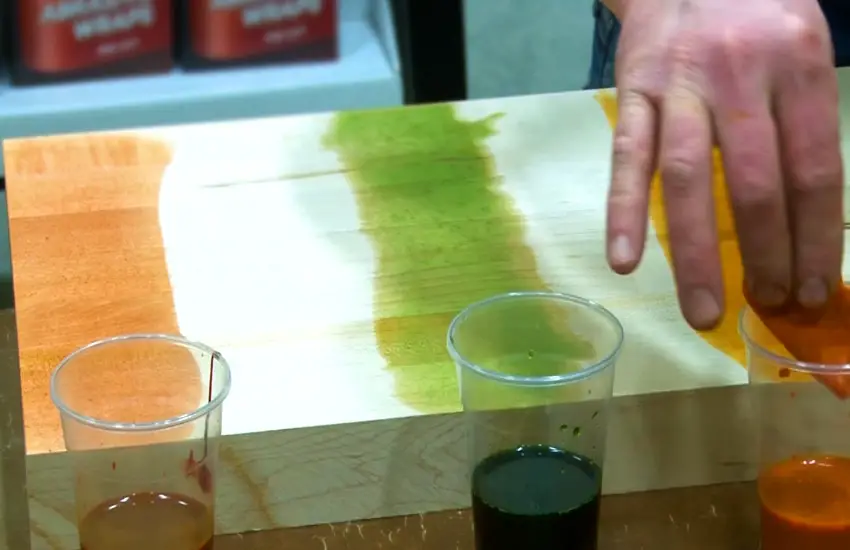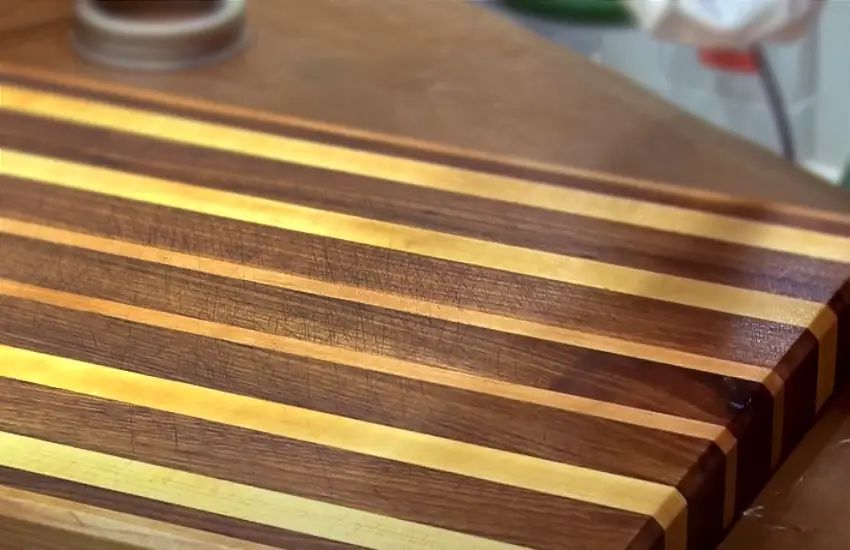As an Amazon Associate, I earn from qualifying purchases at no extra cost to you.
Can You Stain a Cutting Board? Discover the Best Methods!
Ever wondered if you can make your cutting board look nicer? Well, you can! Staining a cutting board might sound tough, but it’s not. It’s like giving it a new color. Staining can make your cutting board look better and last longer. But wait! Before you start, let’s understand some basics.
Staining is just changing the color of something. Whether you want it darker or lighter, staining can do it. But not all cutting boards are the same, so how you stain them might be different. Let’s learn how to stain your cutting board so it looks awesome and stays strong!

Why Staining A Cutting Board Matters
When it comes to maintaining the longevity of your cutting board, staining is a crucial step in the process. By understanding why staining a cutting board matters, you can ensure that your kitchen essentials remain in optimal condition for years to come.
Protecting The Surface
Staining a cutting board forms a protective barrier that prevents moisture and bacteria from seeping into the wood. This essential layer helps to maintain the integrity of the cutting board’s surface, reducing the risk of warping, cracking, and mold growth.
Preserving The Appearance
Staining the cutting board not only enhances its natural beauty but also safeguards it from unsightly stains and discoloration. This added layer of protection preserves the visual appeal of the cutting board, making it a focal point of your kitchen for years to come.
The Different Types Of Cutting Board Materials
When it comes to selecting a cutting board, there are various materials to choose from. The type of material you choose can significantly impact the durability, maintenance, and overall performance of the cutting board. In this section, we will explore the different types of cutting board materials available on the market, namely: wooden cutting boards, plastic cutting boards, and bamboo cutting boards.
Wooden Cutting Boards
Wooden cutting boards are a classic choice that offers both functionality and aesthetic appeal. They are known for their durability and ability to withstand heavy cutting. Additionally, wooden cutting boards are gentle on knife blades, reducing the risk of dulling the edge. The natural properties of wood make it naturally resistant to bacteria, making it a hygienic choice for a cutting surface.
However, it is important to note that wooden cutting boards require regular maintenance to keep them in optimal condition. They should be oiled regularly to prevent drying and cracking. It is also advised to avoid using wooden cutting boards for cutting raw meat, as the porous nature of wood can harbor bacteria.
Plastic Cutting Boards
Plastic cutting boards are a popular choice due to their affordability, ease of cleaning, and versatility. They come in various sizes, colors, and thicknesses, allowing you to choose one that fits your specific needs. Plastic cutting boards are lightweight, making them easy to move and store.
These cutting boards are also dishwasher-safe, which makes for convenient cleaning. They are non-porous, meaning they do not absorb liquids or odors. This property makes plastic cutting boards suitable for cutting raw meat and other potentially messy ingredients.
Bamboo Cutting Boards
Bamboo cutting boards have gained popularity in recent years due to their eco-friendly nature and attractive appearance. Bamboo is a sustainable material that grows quickly, making it an environmentally conscious choice. These cutting boards are highly durable and resistant to moisture, reducing the risk of warping or cracking.
Bamboo cutting boards are also known to be more gentle on knife blades compared to other materials. They require regular oiling to maintain their longevity and prevent drying. Similar to wooden cutting boards, it is advisable to avoid using bamboo cutting boards for cutting raw meat to prevent cross-contamination.
Each type of cutting board material has its unique features and considerations. The choice ultimately depends on personal preference, maintenance preferences, and intended usage. Regardless of the material you choose, proper cleaning and maintenance are crucial to extend the lifespan of the cutting board and ensure hygienic food preparation.
Methods For Staining A Cutting Board
When it comes to staining a cutting board, there are a few different methods that you can use to achieve beautiful and long-lasting results. Two popular options are using food-grade mineral oil and applying a beeswax and oil blend. Both of these methods offer protection for your cutting board while enhancing its appearance. Let’s take a closer look at each method.
Using Food-Grade Mineral Oil
Food-grade mineral oil is a safe and effective option for staining and preserving a cutting board. This type of mineral oil is specifically designed for use with food-contact surfaces, making it perfect for kitchen tools such as cutting boards. Here’s how you can use food-grade mineral oil to stain your cutting board:
- Clean the cutting board thoroughly with warm soapy water and let it dry completely.
- Apply a generous amount of food-grade mineral oil to the board, ensuring that you cover the entire surface.
- Allow the oil to penetrate the wood for about 15-20 minutes.
- Wipe off any excess oil with a clean cloth.
- Repeat this process 2-3 times, allowing each coat of oil to dry before applying the next one.
By following these steps, you can achieve a deeper color and a moisture-resistant finish that will make your cutting board look as good as new.
Applying Beeswax And Oil Blend
Another popular method for staining a cutting board is to use a beeswax and oil blend. This combination provides a natural protective barrier while giving the board a beautiful, warm glow. Here’s how you can apply a beeswax and oil blend to your cutting board:
Materials:
- Beeswax
- Mineral oil or food-grade oil
- Clean cloth or brush
- Plastic wrap
- Clean cloth
Instructions:
- Start by melting the beeswax in a double boiler or microwave-safe container.
- Once the beeswax is melted, mix it with an equal amount of mineral oil or food-safe oil.
- Apply the mixture to the cutting board using a clean cloth or brush, making sure to cover the entire surface.
- 4. Cover the cutting board with plastic wrap and let it sit for at least 4 hours or overnight.- Clean cloth5. Remove the plastic wrap and wipe off any excess wax and oil with a clean cloth.
This method not only adds a rich color to the wood but also creates a protective layer that helps to prevent moisture absorption and minimize the risk of bacteria growth.
Using these methods, you can easily stain and protect your cutting board, ensuring its longevity and maintaining its visual appeal. Whether you choose to use food-grade mineral oil or beeswax and oil blend, your cutting board will thank you for the extra care and attention.
Tips And Tricks For Maintaining And Repairing Stained Cutting Boards
We’ll share valuable tips and tricks for maintaining and repairing stained cutting boards. From regular cleaning and oiling to removing stains and even sanding and resurfacing, we’ve got you covered. Let’s dive in and explore the best ways to keep your cutting board in pristine condition.

Regular Cleaning And Oiling
Regular cleaning and oiling are essential for preserving the life and integrity of your cutting board. Here are some quick tips:
- Wash your cutting board with hot, soapy water after each use
- Dry the board thoroughly before storing it
- Apply a food-safe mineral oil to the board at regular intervals to prevent it from drying out and cracking
- Consider using beeswax for an additional layer of protection
Removing Stains
If you notice stains on your cutting board, don’t worry. Here’s how you can effectively remove them:
- Lemon and Salt: Rub the stained area with a lemon half and a generous amount of salt, then rinse with water
- Baking Soda Paste: Create a paste using baking soda and water, apply to the stained area, scrub gently, and rinse thoroughly
- Vinegar and Water: Soak a cloth in a mixture of vinegar and water, lay it over the stained area, and let it sit for a few hours before rinsing
Sanding And Resurfacing
When stains are particularly stubborn or your cutting board begins to show signs of wear and tear, sanding and resurfacing can help revive its appearance and functionality. Here’s a simple guide:
- Fine Sandpaper: Use fine sandpaper to gently sand the surface of the cutting board, removing stains and smoothing out any scratches
- Apply Mineral Oil: Once the board is sanded, apply a generous amount of food-safe mineral oil to restore moisture and protect the surface
Final Words
Staining a cutting board provides both aesthetic appeal and practical benefits. With the right techniques and materials, you can enhance the appearance of your cutting board while also protecting it from moisture and bacteria. Ultimately, with proper maintenance, a stained cutting board can become a long-lasting and indispensable kitchen tool.
